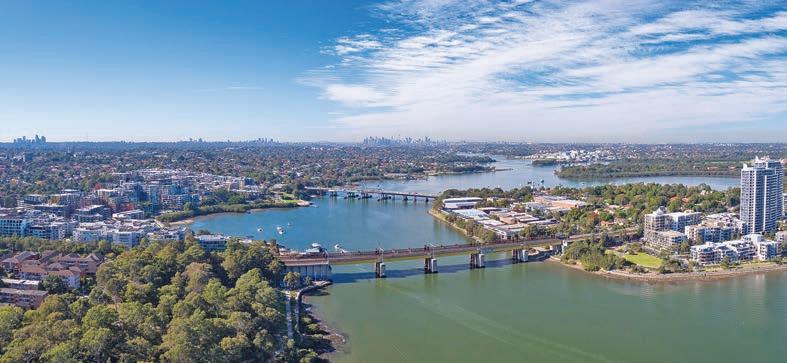
3 minute read
Ryde makes a clean splash
Ryde’s zero litter an Australian first
The City of Ryde is the first council in Australia to adopt a target of zero litter into rivers for 2030, which means plenty of new initiatives to ensure no pollutants are discharged into any of Ryde’s waterways – and from there, to the ocean.
Aerial view over Parramatta River foreshore looking to the city
“A Zero Litter to River target in the City of Ryde will stop more than 1,500 tonnes of gross pollutants from the Ryde area entering downstream waterways such as the Lane Cover and Parramatta Rivers,” said City of Ryde Mayor, Clr Jerome Laxale.

“It will help us achieve our goal to make the Parramatta River swimmable again – with the assistance of the Parramatta River Catchment Group,” he said. Actions to achieve the target will include: • Rectification of selected existing stormwater treatment assets
• Installation of new stormwater treatment assets

• Appropriate management of new and existing stormwater treatment assets • Identify funding to activate and continue the initiatives
City of Ryde and many other councils have been hearing from underground stormwater infrastructure company, Ocean Protect, whose co-founder Jeremy Brown believes oceans are in crisis, with plastics a big part of the problem. Other pollutants include sediments, heavy metals, nitrogen, phosphorous and cigarette butts, all from stormwater runoff. Ocean Protect has worked for two decades on design, installation and maintenance of stormwater treatment assets and infrastructure and has been increasingly disturbed by the amount of rubbish clogging up both oceans and infrastructure. Plastic, equal to the contents of one garbage truck dumped into the ocean every minute, goes into the ocean from Australian waterways, adding up to more than 8m tonnes p.a. Four-fifths of this comes from land-based sources through drains, into local waterways then oceans via stormwater runoff. Meanwhile, on the other side of the world, India is set to impose a nationwide ban on plastic bags, cups and straws in its most sweeping move to stamp out singleuse plastics from cities and villages that rank among the world’s most polluted.


Reversal of shocking council bill
A NSW Government decision last month to reverse a sudden, huge hike in emergency services levies on councils and ratepayers will be a relief to all.
The policy reversal will see State Government pay what was to be an initial increase of almost $14 million in emergency services levies paid by councils. A transition to increased levies is still to be worked out. With virtually no notice from NSW Government, council contributions were about to soar to cover extension of workers' compensation for volunteer and career firefighters diagnosed with any of about a dozen work-related cancers. Local Government NSW (LGNSW) President, Linda Scott, said the news followed months of lobbying by LGNSW and councils across the State and was a clear indication that “the NSW Government was genuinely committed to an equal partnership with local government”. “Local government strongly supports fairer workers’ compensation for paid and volunteer fire fighters,” Clr Scott said. “In many areas, especially in regional NSW, mayors, councillors and council staff are core volunteers making up our State’s rural fire brigades.” At the moment, councils contribute 11.7 % of the emergency services budget in NSW, through council rates and insurance premiums. The first councils knew of an increase was May when they opened a bill for 2019-20 from Revenue NSW too see annual levy hikes of up to $220,000 per council – up between 11% and 25%. The increase for Lane Cove was to be $80,000 for the year; some of the hardest-hit councils are already struggling to support communities through drought, and were simply unable to pay an increase. LGA NSW expects State and local government will develop a “fair and realistic transition process” towards fully funded workers’ compensation for NSW firefighters and their families.






